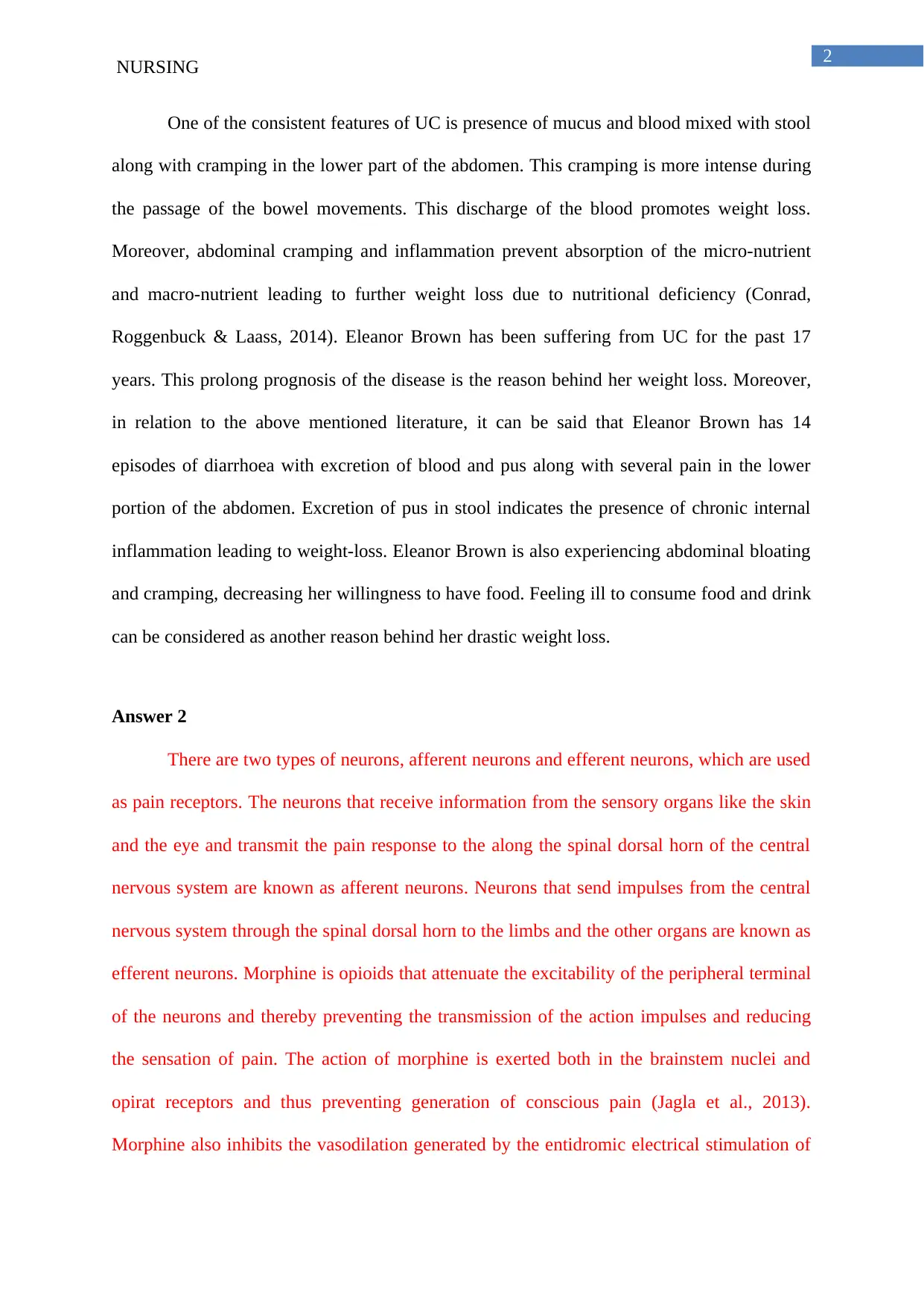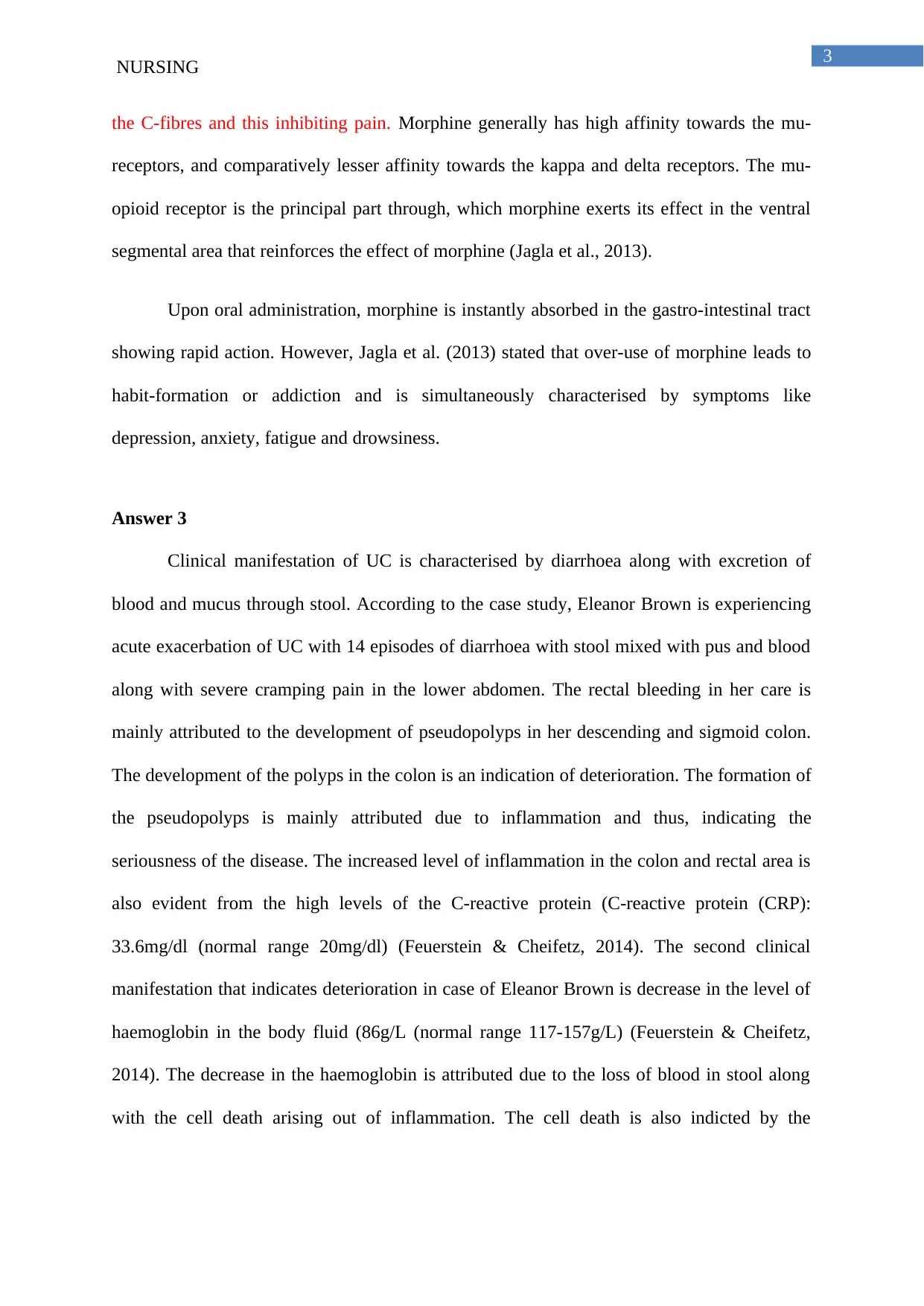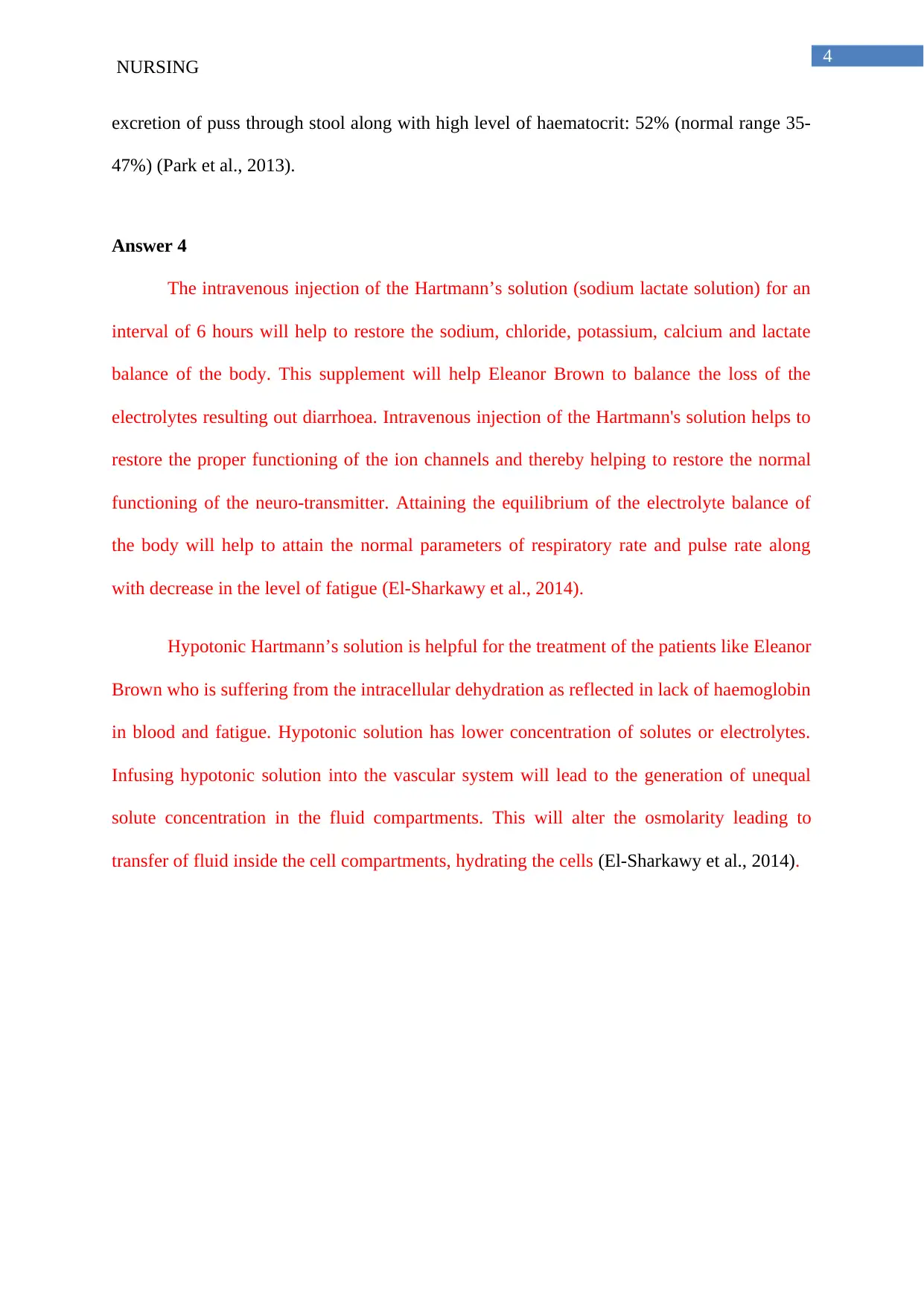Western Sydney University - Ulcerative Colitis Case Study Analysis
VerifiedAdded on 2023/04/10
|7
|1353
|108
Homework Assignment
AI Summary
This assignment focuses on a case study of Eleanor Brown, a patient with a 17-year history of ulcerative colitis (UC). It explains the pathophysiology behind the weight loss associated with UC, detailing the inflammatory processes, hormonal imbalances, and malabsorption issues. The assignment also discusses the role of afferent and efferent neurons in pain reception and the mechanism of morphine in pain management. Furthermore, it identifies the clinical manifestations of UC deterioration in Eleanor Brown's case, such as rectal bleeding, pseudopolyp development, elevated C-reactive protein levels, and decreased hemoglobin. Finally, it justifies the use of intravenous Hartmann's solution to restore electrolyte balance and address intracellular dehydration. This assignment is available on Desklib, where students can find a wealth of study resources, including past papers and solved assignments.

Running head: NURSING
Name of the Student
Ashma Gyawali Kharel
Name of the University
Western Sydney University
Name of the Student
Ashma Gyawali Kharel
Name of the University
Western Sydney University
Paraphrase This Document
Need a fresh take? Get an instant paraphrase of this document with our AI Paraphraser

1
NURSING
Answer 1
Ulcerative colitis (UC) is a chronic disease that leads to inflammation or irritation and
sores (commonly known as ulcers) in the inner lining of the large intestine. It is classified
under the chronic inflammatory disease of the gastro-intestinal (GI) tract, known as
inflammatory bowel disease (IBD). UC has slow prognosis initially and during the course of
time it becomes worse (National Institute of Diabetes and Digestive and Kidney Diseases
[NIDDK], 2019).
Weight-loss is one of the common sign and symptom of UC, and is mainly driven by
the morphologic and inflammatory changes in the colon. During the initial stages of the UC,
the inflammation is limited to mucosa and mainly consists of constant involvement of the
differing severity of ulceration, edema and haemorrhage along the length of the colon. Thus,
weigh loss is not drastic at the initial stage. However, as the disease progresses there occurs
distortion of the mucosal glands and depletion of the goblet cells due to infiltration of the
colon area by the polymorphonuclear leukocytes and mono-nuclear cells leading to the
development of chronic inflammation (Conrad, Roggenbuck & Laass, 2014). Elsherif,
Alexakis and Mendall (2014) stated that inflammatory nature results in the generalised
catabolic resulting in drastic weight loss. Moreover, the resting energy expenditure is found
to increase gradually during the acute flares of the UC and heightened release of the pro-
inflammatory cytokines exert an anorexic effect leading to further loss in the bio-mass.
Elsherif, Alexakis and Mendall (2014) further highlighted that the inflammatory state of the
UC is also associated with the changes in the level of numerous metabolic hormones
secretion like leptin, ghrelin and adiponectin. Dis-equilibrium in hormonal secretion leads to
hamper in the balance of the satiety leading to weight loss.
NURSING
Answer 1
Ulcerative colitis (UC) is a chronic disease that leads to inflammation or irritation and
sores (commonly known as ulcers) in the inner lining of the large intestine. It is classified
under the chronic inflammatory disease of the gastro-intestinal (GI) tract, known as
inflammatory bowel disease (IBD). UC has slow prognosis initially and during the course of
time it becomes worse (National Institute of Diabetes and Digestive and Kidney Diseases
[NIDDK], 2019).
Weight-loss is one of the common sign and symptom of UC, and is mainly driven by
the morphologic and inflammatory changes in the colon. During the initial stages of the UC,
the inflammation is limited to mucosa and mainly consists of constant involvement of the
differing severity of ulceration, edema and haemorrhage along the length of the colon. Thus,
weigh loss is not drastic at the initial stage. However, as the disease progresses there occurs
distortion of the mucosal glands and depletion of the goblet cells due to infiltration of the
colon area by the polymorphonuclear leukocytes and mono-nuclear cells leading to the
development of chronic inflammation (Conrad, Roggenbuck & Laass, 2014). Elsherif,
Alexakis and Mendall (2014) stated that inflammatory nature results in the generalised
catabolic resulting in drastic weight loss. Moreover, the resting energy expenditure is found
to increase gradually during the acute flares of the UC and heightened release of the pro-
inflammatory cytokines exert an anorexic effect leading to further loss in the bio-mass.
Elsherif, Alexakis and Mendall (2014) further highlighted that the inflammatory state of the
UC is also associated with the changes in the level of numerous metabolic hormones
secretion like leptin, ghrelin and adiponectin. Dis-equilibrium in hormonal secretion leads to
hamper in the balance of the satiety leading to weight loss.

2
NURSING
One of the consistent features of UC is presence of mucus and blood mixed with stool
along with cramping in the lower part of the abdomen. This cramping is more intense during
the passage of the bowel movements. This discharge of the blood promotes weight loss.
Moreover, abdominal cramping and inflammation prevent absorption of the micro-nutrient
and macro-nutrient leading to further weight loss due to nutritional deficiency (Conrad,
Roggenbuck & Laass, 2014). Eleanor Brown has been suffering from UC for the past 17
years. This prolong prognosis of the disease is the reason behind her weight loss. Moreover,
in relation to the above mentioned literature, it can be said that Eleanor Brown has 14
episodes of diarrhoea with excretion of blood and pus along with several pain in the lower
portion of the abdomen. Excretion of pus in stool indicates the presence of chronic internal
inflammation leading to weight-loss. Eleanor Brown is also experiencing abdominal bloating
and cramping, decreasing her willingness to have food. Feeling ill to consume food and drink
can be considered as another reason behind her drastic weight loss.
Answer 2
There are two types of neurons, afferent neurons and efferent neurons, which are used
as pain receptors. The neurons that receive information from the sensory organs like the skin
and the eye and transmit the pain response to the along the spinal dorsal horn of the central
nervous system are known as afferent neurons. Neurons that send impulses from the central
nervous system through the spinal dorsal horn to the limbs and the other organs are known as
efferent neurons. Morphine is opioids that attenuate the excitability of the peripheral terminal
of the neurons and thereby preventing the transmission of the action impulses and reducing
the sensation of pain. The action of morphine is exerted both in the brainstem nuclei and
opirat receptors and thus preventing generation of conscious pain (Jagla et al., 2013).
Morphine also inhibits the vasodilation generated by the entidromic electrical stimulation of
NURSING
One of the consistent features of UC is presence of mucus and blood mixed with stool
along with cramping in the lower part of the abdomen. This cramping is more intense during
the passage of the bowel movements. This discharge of the blood promotes weight loss.
Moreover, abdominal cramping and inflammation prevent absorption of the micro-nutrient
and macro-nutrient leading to further weight loss due to nutritional deficiency (Conrad,
Roggenbuck & Laass, 2014). Eleanor Brown has been suffering from UC for the past 17
years. This prolong prognosis of the disease is the reason behind her weight loss. Moreover,
in relation to the above mentioned literature, it can be said that Eleanor Brown has 14
episodes of diarrhoea with excretion of blood and pus along with several pain in the lower
portion of the abdomen. Excretion of pus in stool indicates the presence of chronic internal
inflammation leading to weight-loss. Eleanor Brown is also experiencing abdominal bloating
and cramping, decreasing her willingness to have food. Feeling ill to consume food and drink
can be considered as another reason behind her drastic weight loss.
Answer 2
There are two types of neurons, afferent neurons and efferent neurons, which are used
as pain receptors. The neurons that receive information from the sensory organs like the skin
and the eye and transmit the pain response to the along the spinal dorsal horn of the central
nervous system are known as afferent neurons. Neurons that send impulses from the central
nervous system through the spinal dorsal horn to the limbs and the other organs are known as
efferent neurons. Morphine is opioids that attenuate the excitability of the peripheral terminal
of the neurons and thereby preventing the transmission of the action impulses and reducing
the sensation of pain. The action of morphine is exerted both in the brainstem nuclei and
opirat receptors and thus preventing generation of conscious pain (Jagla et al., 2013).
Morphine also inhibits the vasodilation generated by the entidromic electrical stimulation of
⊘ This is a preview!⊘
Do you want full access?
Subscribe today to unlock all pages.

Trusted by 1+ million students worldwide

3
NURSING
the C-fibres and this inhibiting pain. Morphine generally has high affinity towards the mu-
receptors, and comparatively lesser affinity towards the kappa and delta receptors. The mu-
opioid receptor is the principal part through, which morphine exerts its effect in the ventral
segmental area that reinforces the effect of morphine (Jagla et al., 2013).
Upon oral administration, morphine is instantly absorbed in the gastro-intestinal tract
showing rapid action. However, Jagla et al. (2013) stated that over-use of morphine leads to
habit-formation or addiction and is simultaneously characterised by symptoms like
depression, anxiety, fatigue and drowsiness.
Answer 3
Clinical manifestation of UC is characterised by diarrhoea along with excretion of
blood and mucus through stool. According to the case study, Eleanor Brown is experiencing
acute exacerbation of UC with 14 episodes of diarrhoea with stool mixed with pus and blood
along with severe cramping pain in the lower abdomen. The rectal bleeding in her care is
mainly attributed to the development of pseudopolyps in her descending and sigmoid colon.
The development of the polyps in the colon is an indication of deterioration. The formation of
the pseudopolyps is mainly attributed due to inflammation and thus, indicating the
seriousness of the disease. The increased level of inflammation in the colon and rectal area is
also evident from the high levels of the C-reactive protein (C-reactive protein (CRP):
33.6mg/dl (normal range 20mg/dl) (Feuerstein & Cheifetz, 2014). The second clinical
manifestation that indicates deterioration in case of Eleanor Brown is decrease in the level of
haemoglobin in the body fluid (86g/L (normal range 117-157g/L) (Feuerstein & Cheifetz,
2014). The decrease in the haemoglobin is attributed due to the loss of blood in stool along
with the cell death arising out of inflammation. The cell death is also indicted by the
NURSING
the C-fibres and this inhibiting pain. Morphine generally has high affinity towards the mu-
receptors, and comparatively lesser affinity towards the kappa and delta receptors. The mu-
opioid receptor is the principal part through, which morphine exerts its effect in the ventral
segmental area that reinforces the effect of morphine (Jagla et al., 2013).
Upon oral administration, morphine is instantly absorbed in the gastro-intestinal tract
showing rapid action. However, Jagla et al. (2013) stated that over-use of morphine leads to
habit-formation or addiction and is simultaneously characterised by symptoms like
depression, anxiety, fatigue and drowsiness.
Answer 3
Clinical manifestation of UC is characterised by diarrhoea along with excretion of
blood and mucus through stool. According to the case study, Eleanor Brown is experiencing
acute exacerbation of UC with 14 episodes of diarrhoea with stool mixed with pus and blood
along with severe cramping pain in the lower abdomen. The rectal bleeding in her care is
mainly attributed to the development of pseudopolyps in her descending and sigmoid colon.
The development of the polyps in the colon is an indication of deterioration. The formation of
the pseudopolyps is mainly attributed due to inflammation and thus, indicating the
seriousness of the disease. The increased level of inflammation in the colon and rectal area is
also evident from the high levels of the C-reactive protein (C-reactive protein (CRP):
33.6mg/dl (normal range 20mg/dl) (Feuerstein & Cheifetz, 2014). The second clinical
manifestation that indicates deterioration in case of Eleanor Brown is decrease in the level of
haemoglobin in the body fluid (86g/L (normal range 117-157g/L) (Feuerstein & Cheifetz,
2014). The decrease in the haemoglobin is attributed due to the loss of blood in stool along
with the cell death arising out of inflammation. The cell death is also indicted by the
Paraphrase This Document
Need a fresh take? Get an instant paraphrase of this document with our AI Paraphraser

4
NURSING
excretion of puss through stool along with high level of haematocrit: 52% (normal range 35-
47%) (Park et al., 2013).
Answer 4
The intravenous injection of the Hartmann’s solution (sodium lactate solution) for an
interval of 6 hours will help to restore the sodium, chloride, potassium, calcium and lactate
balance of the body. This supplement will help Eleanor Brown to balance the loss of the
electrolytes resulting out diarrhoea. Intravenous injection of the Hartmann's solution helps to
restore the proper functioning of the ion channels and thereby helping to restore the normal
functioning of the neuro-transmitter. Attaining the equilibrium of the electrolyte balance of
the body will help to attain the normal parameters of respiratory rate and pulse rate along
with decrease in the level of fatigue (El-Sharkawy et al., 2014).
Hypotonic Hartmann’s solution is helpful for the treatment of the patients like Eleanor
Brown who is suffering from the intracellular dehydration as reflected in lack of haemoglobin
in blood and fatigue. Hypotonic solution has lower concentration of solutes or electrolytes.
Infusing hypotonic solution into the vascular system will lead to the generation of unequal
solute concentration in the fluid compartments. This will alter the osmolarity leading to
transfer of fluid inside the cell compartments, hydrating the cells (El-Sharkawy et al., 2014).
NURSING
excretion of puss through stool along with high level of haematocrit: 52% (normal range 35-
47%) (Park et al., 2013).
Answer 4
The intravenous injection of the Hartmann’s solution (sodium lactate solution) for an
interval of 6 hours will help to restore the sodium, chloride, potassium, calcium and lactate
balance of the body. This supplement will help Eleanor Brown to balance the loss of the
electrolytes resulting out diarrhoea. Intravenous injection of the Hartmann's solution helps to
restore the proper functioning of the ion channels and thereby helping to restore the normal
functioning of the neuro-transmitter. Attaining the equilibrium of the electrolyte balance of
the body will help to attain the normal parameters of respiratory rate and pulse rate along
with decrease in the level of fatigue (El-Sharkawy et al., 2014).
Hypotonic Hartmann’s solution is helpful for the treatment of the patients like Eleanor
Brown who is suffering from the intracellular dehydration as reflected in lack of haemoglobin
in blood and fatigue. Hypotonic solution has lower concentration of solutes or electrolytes.
Infusing hypotonic solution into the vascular system will lead to the generation of unequal
solute concentration in the fluid compartments. This will alter the osmolarity leading to
transfer of fluid inside the cell compartments, hydrating the cells (El-Sharkawy et al., 2014).

5
NURSING
References
Conrad, K., Roggenbuck, D., & Laass, M. W. (2014). Diagnosis and classification of
ulcerative colitis. Autoimmunity reviews, 13(4-5), 463-466.
El-Sharkawy, A. M., Sahota, O., Maughan, R. J., & Lobo, D. N. (2014). The pathophysiology
of fluid and electrolyte balance in the older adult surgical patient. Clinical
Nutrition, 33(1), 6-13.
Elsherif, Y., Alexakis, C., & Mendall, M. (2014). Determinants of weight loss prior to
diagnosis in inflammatory bowel disease: a retrospective observational
study. Gastroenterology research and practice, 2014.
Feuerstein, J. D., & Cheifetz, A. S. (2014, November). Ulcerative colitis: epidemiology,
diagnosis, and management. In Mayo Clinic Proceedings (Vol. 89, No. 11, pp. 1553-
1563). Elsevier.
Jagla, G., Mika, J., Makuch, W., Obara, I., Wordliczek, J., & Przewlocka, B. (2014).
Analgesic effects of antidepressants alone and after their local co-administration with
morphine in a rat model of neuropathic pain. Pharmacological Reports, 66(3), 459-
465.
National Institute of Diabetes and Digestive and Kidney Diseases [NIDDK] (2019).
Ulcerative Colitis. Access date: 2th March 2019. Retrieved from:
https://www.niddk.nih.gov/health-information/digestive-diseases/ulcerative-colitis
Park, S. H., Kim, D., Ye, B. D., Yang, S. K., Kim, J. H., Yang, D. H., ... & Kim, M. H.
(2013). The characteristics of ulcerative colitis associated with autoimmune
pancreatitis. Journal of clinical gastroenterology, 47(6), 520-525.
NURSING
References
Conrad, K., Roggenbuck, D., & Laass, M. W. (2014). Diagnosis and classification of
ulcerative colitis. Autoimmunity reviews, 13(4-5), 463-466.
El-Sharkawy, A. M., Sahota, O., Maughan, R. J., & Lobo, D. N. (2014). The pathophysiology
of fluid and electrolyte balance in the older adult surgical patient. Clinical
Nutrition, 33(1), 6-13.
Elsherif, Y., Alexakis, C., & Mendall, M. (2014). Determinants of weight loss prior to
diagnosis in inflammatory bowel disease: a retrospective observational
study. Gastroenterology research and practice, 2014.
Feuerstein, J. D., & Cheifetz, A. S. (2014, November). Ulcerative colitis: epidemiology,
diagnosis, and management. In Mayo Clinic Proceedings (Vol. 89, No. 11, pp. 1553-
1563). Elsevier.
Jagla, G., Mika, J., Makuch, W., Obara, I., Wordliczek, J., & Przewlocka, B. (2014).
Analgesic effects of antidepressants alone and after their local co-administration with
morphine in a rat model of neuropathic pain. Pharmacological Reports, 66(3), 459-
465.
National Institute of Diabetes and Digestive and Kidney Diseases [NIDDK] (2019).
Ulcerative Colitis. Access date: 2th March 2019. Retrieved from:
https://www.niddk.nih.gov/health-information/digestive-diseases/ulcerative-colitis
Park, S. H., Kim, D., Ye, B. D., Yang, S. K., Kim, J. H., Yang, D. H., ... & Kim, M. H.
(2013). The characteristics of ulcerative colitis associated with autoimmune
pancreatitis. Journal of clinical gastroenterology, 47(6), 520-525.
⊘ This is a preview!⊘
Do you want full access?
Subscribe today to unlock all pages.

Trusted by 1+ million students worldwide

6
NURSING
NURSING
1 out of 7
Related Documents
Your All-in-One AI-Powered Toolkit for Academic Success.
+13062052269
info@desklib.com
Available 24*7 on WhatsApp / Email
![[object Object]](/_next/static/media/star-bottom.7253800d.svg)
Unlock your academic potential
Copyright © 2020–2025 A2Z Services. All Rights Reserved. Developed and managed by ZUCOL.




